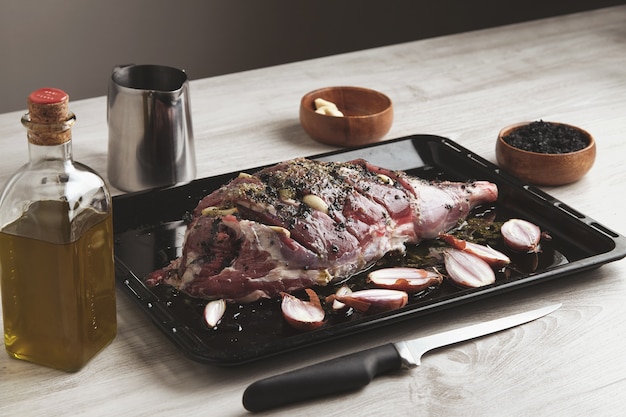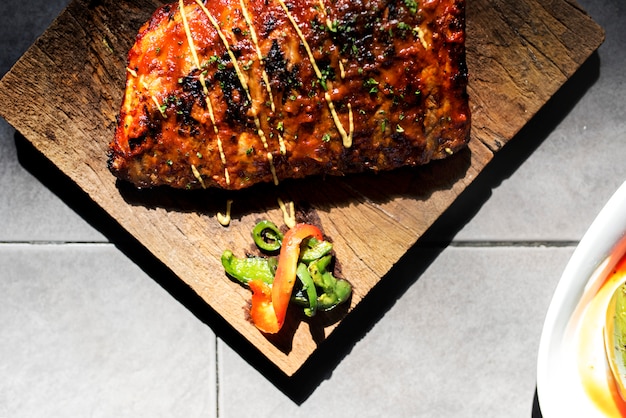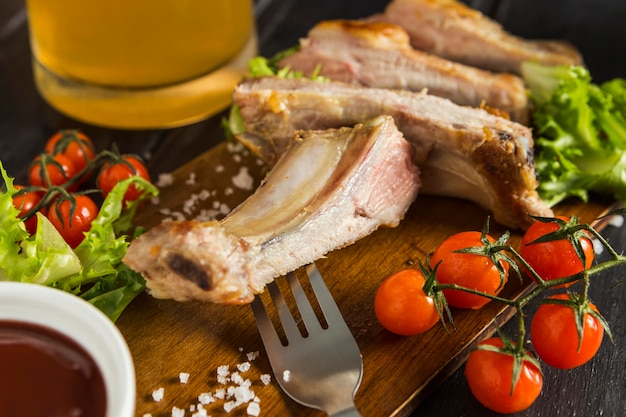Let's face it, there's nothing quite as satisfying as a perfectly cooked pork shoulder. It’s a magical combination of flavour and texture, melting in your mouth with every bite. But achieving that culinary nirvana takes more than just chucking a hunk of meat in the oven and hoping for the best. It's about understanding the cut, mastering the cooking techniques, and embracing the art of seasoning. I’ve been cooking with pork shoulder for years, and I'm here to share all my tips and tricks to help you achieve pork shoulder perfection.
(Part 1) The Pork Shoulder Primer: Getting to Know Your Meat

choosing the right cut: Boston Butt vs. Picnic Shoulder
The first step to pork shoulder greatness is picking the right cut. There are two main contenders:
Boston Butt: This is the top part of the shoulder and has a higher fat content, leading to incredible juiciness. It’s the classic choice for pulled pork sandwiches and other slow-cooked dishes.
Picnic Shoulder: This is the bottom part, with more connective tissue than the Boston Butt. Don't let that scare you off! This tissue breaks down beautifully during cooking, yielding a melt-in-your-mouth experience.
I prefer the Boston Butt for its rich flavour, but both cuts will give you amazing results.
Understanding the Fat: Embrace the Marbling
Don't be afraid of the fat marbling in your pork shoulder. It's your secret weapon for flavour and moisture. During cooking, the fat melts down and renders, creating a delicious sauce that coats the meat. While you can trim some of the fat, don't go overboard. You need a good amount to keep the meat succulent.
(Part 2) The Magic of Low and Slow: Unlocking Tenderness

Why Low and Slow is the Key: Breaking Down Tough Muscle
The key to tender, juicy pork shoulder lies in slow cooking. This method allows the tough muscle fibres to break down, creating a texture that's so tender it practically melts in your mouth.
Slow Cooking Methods: Exploring Your Options
There are a few tried and true methods for slow cooking pork shoulder:
slow cooker: This is the easiest and most hands-off method. Throw your seasoned pork shoulder in the slow cooker, set it on low for 6-8 hours (or on high for 4-6 hours), and let it do its magic.
Oven: The oven is a classic slow cooking method. Roast your pork shoulder at a low temperature (around 150-160 degrees Celsius or 300-325 degrees Fahrenheit) for 4-6 hours, or until it reaches an internal temperature of 90 degrees Celsius (195 degrees Fahrenheit).
Smoker: For the BBQ enthusiasts, smoking your pork shoulder is a fantastic way to add a rich smoky flavour. Smoke it low and slow (around 110 degrees Celsius or 225 degrees Fahrenheit) for 6-8 hours, or until it reaches an internal temperature of 90 degrees Celsius (195 degrees Fahrenheit).
The Internal Temperature Rule: Safety First
Always use a meat thermometer to check the internal temperature of your pork shoulder. It should reach an internal temperature of 90 degrees Celsius (195 degrees Fahrenheit) to ensure it’s cooked through and safe to eat.
(Part 3) Seasoning Your Pork Shoulder: A Symphony of Flavour

Basic Seasoning: Keeping it Simple and Delicious
For a classic, straightforward flavour, you can’t go wrong with a simple combination of salt, pepper, and garlic powder. This trio allows the natural flavour of the pork to shine through.
Adding a Spicy Kick: Infusing Heat
For a touch of heat, spice up your seasoning with chili powder, paprika, or cayenne pepper. Experiment with different chili peppers for a unique kick.
Sweet and Savoury: Balancing the Taste Buds
For a sweet and savoury twist, add a tablespoon or two of brown sugar, maple syrup, or honey to your seasoning mix. This will create a delicious glaze that adds depth to your pork shoulder.
Herbal Delights: Bringing in Freshness
Fresh herbs can add a delightful dimension to your pork shoulder. Try rosemary, thyme, oregano, or sage for a rustic, earthy flavour.
Rubs and Marinades: Taking Seasoning to the Next Level
For an even more intense flavour, create a dry rub or marinade. Here are a few ideas:
Dry Rub: Combine salt, pepper, garlic powder, paprika, onion powder, and cumin. Rub this mixture all over the pork shoulder and let it sit for at least 30 minutes, or even overnight.
Marinade: Combine soy sauce, honey, ginger, garlic, and sesame oil. Marinate the pork shoulder for at least 2 hours, or overnight, for a rich and flavourful experience.
(Part 4) Slow Cooking Methods: Step-by-Step Guides
Slow Cooker: Effortless Pork Shoulder Perfection
1. Season: Rub your chosen seasoning mix all over the pork shoulder.
2. Place: Place the pork shoulder in your slow cooker.
3. Cook: Cook on low for 6-8 hours, or on high for 4-6 hours.
4. Shred: Once cooked, remove the pork shoulder from the slow cooker and let it rest for 10-15 minutes. Then, shred it using two forks.
5. Sauce: You can use the cooking juices from the slow cooker as a sauce, or you can make a separate sauce.
Oven: The Traditional Approach
1. Season: Rub your chosen seasoning mix all over the pork shoulder.
2. Place: Place the pork shoulder in a roasting pan.
3. Cook: Cook in the oven at a low temperature (around 150-160 degrees Celsius or 300-325 degrees Fahrenheit) for 4-6 hours, or until it reaches an internal temperature of 90 degrees Celsius (195 degrees Fahrenheit).
4. Rest: Remove the pork shoulder from the oven and let it rest for 10-15 minutes before shredding.
5. Sauce: You can use the cooking juices from the roasting pan as a sauce, or you can make a separate sauce.
Smoker: For the BBQ Enthusiast
1. Season: Rub your chosen seasoning mix all over the pork shoulder.
2. Place: Place the pork shoulder in the smoker.
3. Cook: Cook at a low temperature (around 110 degrees Celsius or 225 degrees Fahrenheit) for 6-8 hours, or until it reaches an internal temperature of 90 degrees Celsius (195 degrees Fahrenheit).
4. Rest: Remove the pork shoulder from the smoker and let it rest for 10-15 minutes before shredding.
5. Sauce: You can use the cooking juices from the smoker as a sauce, or you can make a separate sauce.
(Part 5) Shredding the Pork: A Delicate Art
Shredding Tips: Getting the Texture Right
Once your pork shoulder is cooked, it's time to shred it. This separates the meat from the fat and makes it easier to use in recipes.
Two Forks: Use two forks to gently pull the meat apart, creating small, bite-sized pieces.
Don't Over-Shred: You want to shred the meat just enough to separate the fibres, not so much that it becomes dry and stringy.
The Stand Mixer: A Time-Saver for Large Batches
If you're making a large batch of pork shoulder, using a stand mixer with the paddle attachment is a game-changer for quick and easy shredding.
The Importance of Resting: Rest for Maximum Juiciness
Don't rush the shredding! It's essential to let the pork shoulder rest for at least 10-15 minutes after cooking. This allows the juices to redistribute throughout the meat, ensuring maximum tenderness and juiciness.
(Part 6) Delicious pork shoulder recipes: A Culinary Feast
Pulled Pork Sandwiches: A Classic for a Reason
This is a classic recipe for a reason! The tender, juicy pork is piled high on a bun with a tangy bbq sauce and crunchy coleslaw. It's a true crowd-pleaser.
Pork Tacos: A Mexican Flavour Explosion
Turn your shredded pork shoulder into mouthwatering tacos! Add some chopped onions, cilantro, and salsa for a burst of authentic Mexican flavour.
Pork Nachos: A Party Favourite
Make a big batch of nachos topped with shredded pork, cheese, jalapenos, sour cream, and guacamole. This is a perfect party snack or a fun meal for friends.
Pork Soup: Warm and Comforting
Add shredded pork shoulder to your favourite soup recipe for a hearty and delicious meal. It adds a satisfying protein element to any soup.
Pork Chili: A Spicy Kick
Shredded pork shoulder is a wonderful addition to chili. Add some kidney beans, tomatoes, and chili powder for a spicy and satisfying dish.
(Part 7) Mastering the Art of Sauces: Elevating Your Pork Shoulder
BBQ Sauce: The Essential Complement
BBQ sauce is a must-have with pulled pork. You can buy your favourite sauce, but making your own is an adventure in flavour. Here are a few tips:
Sweet and Tangy: Use brown sugar, molasses, vinegar, and tomato sauce for a classic sweet and tangy BBQ sauce.
Smoky: Add liquid smoke or smoked paprika for a smoky flavour that complements the pork beautifully.
Spicy: Add chili powder, cayenne pepper, or hot sauce for a spicy kick that will leave you wanting more.
Carolina Mustard Sauce: A Tangy Twist
This sauce, popular in the Carolinas, is made with mustard, vinegar, and spices. It has a tangy and spicy flavour that complements pork shoulder wonderfully.
Vinegar-Based Sauce: A Tangy and Savoury Option
This sauce is made with vinegar, spices, and sometimes onions or peppers. It has a tangy and savoury flavour that works particularly well with smoked pork shoulder.
(Part 8) Serving and Storing Leftovers: Making the Most of Your Pork Shoulder
Serving Suggestions: Presentation Matters
When serving your shredded pork shoulder, get creative with your presentation:
Sandwich: Serve it on buns with your favourite sauce and toppings.
Taco: Fill tortillas with shredded pork, salsa, and your favourite toppings.
Nacho: Top nachos with shredded pork, cheese, and your favourite toppings.
Salad: Add shredded pork to a salad for extra protein and flavour.
Bowl: Serve it in a bowl with rice, beans, and your favourite sauce.
Storing Leftovers: Keeping it Fresh
Store your leftover shredded pork shoulder in an airtight container in the refrigerator for up to 3 days.
Freezing Leftovers: Time-Saving Tips
You can also freeze your leftover shredded pork shoulder for up to 3 months. Place it in a freezer-safe container or bag. To reheat, thaw it in the refrigerator overnight and then reheat it in a skillet or microwave.
(Part 9) FAQs: Answering Your Questions
What's the best way to check if the pork shoulder is cooked?
Use a meat thermometer to check the internal temperature of the pork shoulder. It should reach an internal temperature of 90 degrees Celsius (195 degrees Fahrenheit) for safe consumption.
Can I cook pork shoulder in the instant pot?
Yes, you can cook pork shoulder in the Instant Pot, but the cooking time will be significantly shorter than traditional slow cooking methods. For example, you can cook a 2-3 pound pork shoulder in the Instant Pot on high pressure for 90 minutes, followed by a 10-minute natural release.
Can I cook pork shoulder in the air fryer?
While you can cook pork shoulder in the air fryer, it's not the ideal method for this cut of meat. The air fryer is better suited for smaller, thinner cuts of meat.
What are some good side dishes to serve with pork shoulder?
Some great side dishes to serve with pork shoulder include coleslaw, potato salad, baked beans, cornbread, and macaroni and cheese.
What are some ways to use leftover pork shoulder?
You can use leftover pork shoulder in tacos, nachos, sandwiches, salads, soups, and chilis. You can also use it to make a delicious pork burrito bowl or pork quesadilla.
So there you have it! Your ultimate guide to tender, juicy pork shoulder. Armed with this knowledge, you're ready to create culinary magic in your own kitchen. Happy cooking!
Everyone is watching

How to Cook Frozen Lobster Tails Perfectly: A Step-by-Step Guide
RecipesLobster. Just the word conjures up images of lavish meals, special occasions, and a taste of luxury. But let's...

Pigs in a Blanket Cooking Time: How Long to Bake for Perfect Results
RecipesAh, pigs in a blanket. Just the name conjures up images of those delightful little parcels of crispy pastry en...

Pork Fillet Cooking Time: How Long to Cook It Perfectly
RecipesPork fillet, or tenderloin as it's sometimes called, is a real favourite in our house. It's so versatile, and...

The Ultimate Guide to Cooking Delicious Frankfurters
RecipesLet's face it, we all love a good frankfurter. It's a classic, simple, and always satisfying. But let's be rea...

Wolf Meat Recipes: A Guide to Cooking Wild Game
RecipesLet's be honest, you don't see wolf meat at your local butcher shop every day. It's a bit of a wild card, but ...
